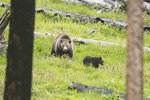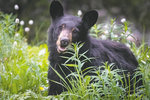Cloudy, 27° F
When animals attack humans in Wyoming, the Game and Fish Department immediately dispatches its Predator Attack Team to assist, investigate and make management decisions. But like many of the …
This item is available in full to subscribers.
The Powell Tribune has expanded its online content. To continue reading, you will need to either log in to your subscriber account, or purchase a subscription.
If you are a current print subscriber, you can set up a free web account by clicking here.
If you already have a web account, but need to reset it, you can do so by clicking here.
If you would like to purchase a subscription click here.
Please log in to continue |
|


When animals attack humans in Wyoming, the Game and Fish Department immediately dispatches its Predator Attack Team to assist, investigate and make management decisions. But like many of the state’s agencies these days, it takes some creativity to find funding for the tools they need to do the job.
Despite its name, the team trains for all sorts of attacks — not just predators. In Wyoming, you never know what the next day brings, said Brian DeBolt, Game and Fish large carnivore conflict coordinator. “They can encompass any kind of wildlife, even if somebody is killed by a moose or something like that.”
In each situation the team scrambles to the location with a list of duties, including helping those injured. While there have been attacks by a number of different species, grizzly bears are responsible for most serious attacks on humans in the state.
“Unfortunately, some of those have been fatal,” DeBolt said during a Wyoming Animal Damage Management Board Zoom meeting last month.
In an effort to purchase tools for the team — tranquilizer guns, rifles and cadaver mannequins — DeBolt asked the board for funding. He made a formal request for $1,850 to buy a tranquilizer gun and about $4,800 for four large-caliber rifles; having the extra tranquilizer gun and rifles would help in situations of public safety, DeBolt said.
The department also requested $5,500 to buy cadaver mannequins and inert shotguns (guns without the firing mechanisms), used for training the team on assisting victims of attacks and management techniques.
“They’re not actual cadavers,” DeBolt told the board. “They’re used to simulate a specific animal [attack] and then we can train … based on the wounds and whatnot. They’re an invaluable tool.”
Unfortunately, the team has had to do some of their training on less than appropriate training tools in the past, he said. “We’ve had to use dolls that we buy at Walmart … They are, quite frankly, unprofessional tools.”
With the mannequins, the team could train members of the team throughout the state on “what to look for, the patterns of attacks, and you can also learn not only what killed the person, but possibly ... the motive behind an animal killing a person, based on what you see on the body,” DeBolt said.
A local issue
There is at least one representative on the Predator Attack Team from each Game and Fish region, but the Cody Region, which includes Park County and the rest of the Big Horn Basin, has five members.
“The bulk of the attacks are coming from the west side of the state because we have grizzly bears,” said Powell Game Warden Chris Queen and member of the team.
Northwest Wyoming has had the highest number of large carnivore attacks in the state, including a June 22 grizzly attack in Yellowstone National Park. A 37-year-old woman from Missouri suffered a minor injury after surprising a female bear while hiking on the Fairy Falls Trail near Old Faithful. It was the year’s first incident involving a bear, but the second in the area. On May 1, a 41-year-old Cody man was attacked and injured by a grizzly bear while hunting for antlers in the Sunlight area.
“Any type of negative wildlife/human interaction is absolutely charged with a ton of emotion,” said Queen. In creating the Predator Attack Team roughly a decade ago, “the department wanted a united team that would would roll into those situations and deal with them in a very professional manner and to a standard protocol,” Queen said.
The team members not only respond to immediate needs after an attack, but they also work to make sure the message coming out of an attack is accurate — both for the sake of the public and predators the department is charged with protecting as part of its management strategy. The state’s role in managing a federally protected species like grizzlies is a delicate balance between protecting the public and predators simultaneously, he said.
“Information can get out so fast that may or may not be accurate, and it can just roll into something that is absolutely 100% wrong,” Queen said. “You can get this mob mentality of, ‘We’re gonna go take care of this ourselves.’”
Conflicts with grizzlies are increasing, according to data collected by the Game and Fish. From 1990-1999, Wyoming saw an average of 79 conflicts a year. From 2000-2009, that number jumped to 150 verified conflicts per year, and from 2010-2018 Wyoming responded to an average of more than 220 verified grizzly bear conflicts, Wyoming Game and Fish Director Brian Nesvik told a congressional committee last year.
Since 2010, there have been seven human deaths in the Greater Yellowstone Ecosystem caused by grizzly bear attacks. From the mid-1980s to 2010, there were none.
“These unfortunate events are the result of more bears in new places,” Nesvik told Congress, adding, “The [demographic monitoring area] was identified as a large enough tract of contiguous habitat to maintain [Greater Yellowstone Ecosystem] grizzly bears in perpetuity. However, because the core of the population has nearly achieved density dependence, grizzly bear distribution has extended far beyond suitable habitats.”
Costly management
Wyoming has spent more than $50 million in grizzly conservation and management programs since the species was listed for federal protection under the Endangered Species Act in 1975. The department has spent almost a third of that, more than $16 million, in the past 10 years.
The U.S. Fish and Wildlife Service, which has the final word in management decisions, contributes about $100,000 per year to grizzly management and conservation programs. Members of the Game and Fish Commission have criticized the amount offered by the federal government.
“We [should] take that measly 100 grand from the feds and tell them to keep it and manage the bears ourselves from this point forward,” Commissioner Mike Schmid, of LaBarge, said at an April 2019 meeting.
No revenue from the state’s general fund is used to support the Game and Fish. Sportsmen and women buying tags and licenses and paying fees, plus federal funds received from taxes on the sale of outdoor equipment (including guns and fishing gear) funds about 85% of the department’s budget.
Looking for grants and other available revenue sources is nothing new for the Game and Fish, said Dan Thompson, Statewide Large Carnivore Supervisor.
“We always look for creative avenues to assist with funding,” Thompson said. “There are items we budget for and grants we apply for to assist with funding our program.”
That’s what brought the department to the Wyoming Animal Damage Management Board on June 4. The board, which is co-chaired by Nesvik, turned down the Game and Fish’s request for funding for the tranquilizer gun and rifles. It did offer to help with the training tools, funding the department $2,750 of the $5,500 requested. The Game and Fish was thrilled to get partial funding from the board, said Rebekah Fitzgerald, communications director for the department.
The board looked at more than $428,000 in requests for funding this year with $274,000 available in the budget.
The department will look for other ways to fund the equipment, Fitzgerald said, but the Predator Attack Team “will have the equipment they need to do their job,” she said.